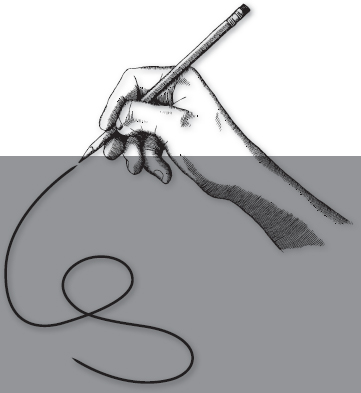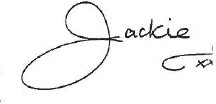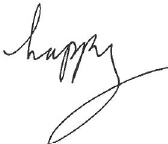
The three zones of expression are the upper, middle, and lower zones. Where there is a lack of proportion or equality among the different zones, the dominant zones will point to the writer's overenthusiastic response in that area. Ideally, all three zones of handwriting should be balanced, showing a well-proportioned script; this scenario signifies the individual who is capable of leading a balanced life.

The upper zone is the area that is covered by the stems of letters such as the lowercase letters d and t and all the capital letters. The upper extensions of the loops of the lowercase letters b, f, h, k, and I can be written in varying degrees of size and height. The top or upper zone reveals idealism, spiritual aspirations, ambitions, and intellect, plus the practicalities of life.
The maturity of an individual can be seen in the size of his or her writing in the upper and lower zones: the mature writer shows no exaggeration in either zone.
If the loops in the upper zone are too high, the individual may be aiming too high in his or her search for perfection, and the subject's idealistic qualities can lack realistic purpose.

Too small or nonexistent upper loops can be an indication of being too matter-of-fact and may suggest a lack of goals in life; this trait also indicates that logic and intellect take priority over emotion.

The writer of oversized upper loops displays a muddled mind, an exaggerated ego, and a tendency to show off and demand attention. This trait can also reveal an individual who shows signs of fantasy and of being a daydreamer; this writer can substitute the imaginary world for reality.

The person who retraces upper loops several times is revealing signs of insecurity and an indication of neurosis. He or she needs to make achievements but may be unable to do much or may be afraid to go forward for fear of making mistakes. This trait can also symbolize the gap between achievement and aspirations, particularly if the loops are oversized.

If the upper-zone loops are too lean and narrow, the writer is either frustrated and restricted or perhaps too rational in his or her thinking. There can be religious leanings, or the absence of physical contact, and a lack of warmth within the family circle when the writer was a child, which prevents the individual from expressing his or her feelings. Thin and narrow loops are an indication of a lack of forward vision, a lack of perception, and stunted warmth.

Fuller loops in the upper zone indicate that the writer is imagintive, friendly, affectionate, and loving. This trait can also reveal liberal sentiments and emotional responses; individuals with this writing style like to express their feelings within friendships and close relationships.

The writer who displays loops sloping to the left of the page within the upper zone can be showing an active inner life, including the traits of contemplation and a tendency to brood on memories and experiences. This writing shows introverted tendencies.
Loops that slope toward the right of the page within the upper zone can indicate intellectual ambitions. The person who shows this writing trait has a lot of drive and energy, with the desire to use his or her mental abilities in a constructive way. The individual whose writing slopes to the right is usually an extrovert.

A handwriting sample with a variety of sizes displayed in the loops of the upper zone, sometimes fluctuating in length and width, can reveal the writer's tendency to vary his or her moods. This individual's ideas and ambitions suffer accordingly, and he or she may be optimistic one day, pessimistic the next.
The middle zone of handwriting reveals whether the writer is a “thinking” or a “feeling” type of person. Letters within the middle zone show whether the writer offers warmth and affection in relationships or prefers to take an analytical and logical approach. This zone can also show the social attitude of the writer.
The middle zone is the area where all lowercase letters without loops are formed; it represents a balance between the upper and lower zones. All lowercase letters should be written at the same height.
The middle zone concerns social life, the emotions, practical behavior, and everyday life. It can show the things that motivate the individual. It shows how someone adapts to circumstances both on a mental and emotional level. Children's writing has a large middle zone.

Avery large script in the middle zone shows that the writer can be self-absorbed; although this individual can be socially outgoing and friendly, he or she can also be egotistical. Such writers might overreact to people and events. Someone whose writing is large in the middle zone area can be generous and extravagant. This trait also shows that this writer can enjoy him- or herself on a grand scale, to the extent of going over the top. Although apparently confident, this person might actually be hiding self-consciousness. Inflated or exaggerated middle-zone writers tend to be somewhat immature in their emotional attitude and can be highly sensitive to any form of personal criticism.
Large middle-zone writers are aware of other people and thrive on being the center of attention and in the thick of a social gathering, such as a party. They love attention and dislike being in the background. Also, a capital letter inserted in the middle zone indicates that the writer seeks acknowledgement and has a desire for recognition. Occasionally, such a capital letter appears in the handwriting of artistic or creative people who want to appear more clever and interesting than they really are. The capital letters that occur most frequently in the middle zone are R and M.

Writers with a small middle zone are thinkers who use an analytical approach to solve the problems of love and life. Such writers usually keep their emotions in check and do not tend to act impulsively or rashly. These people are usually happiest being observers, and they can be less spontaneous than most in their friendships. They tend to hold back on introductions and they do not always trust people.
The lower zone is the area where the traits of physical health, sexual drive, materialistic concerns, and instinctive behavior are seen. This zone is where you find the lower loops of the lowercase script letters f, g, j, p, q, y, and z. Here the personality traits are governed by the length and width of the loops.
The lower zone in handwriting reveals the sexual instincts of the writer; the way the lowercase letters g and y are formed gives the clues to the writer's attitudes and preferences. Whether these letters are written with or without loops, with heavy pressure or light, can reveal quite a lot about the writer's materialistic drives and energy levels. The correct way of writing a g or y is to bring the stroke down, around, and up, crossing over to form a loop.
There are many variations of the loop, and this is where the signs of inhibition, vanity, sensuality, sexuality, and materialism are revealed.
A very long, rounded loop with plenty of pressure within the lower zone is a sign of energy and drive, but also strong sexual inclinations and a need for the writer to express them. This can also show that the writer is fond of playing sports, especially team games.

A thin, wavering down stroke or loop in the lower zone indicates a lack of vitality, energy, or interest in life.

A loop in the lower zone that is short and full with a round base shows a love of flirting and an affectionate and loving nature, but not necessarily a sensual or sexy one. This type of writer will probably enjoy the chase much more than the capture.

An exaggerated g or y in the lower zone with an inflated loop shows that the writer can be boastful; this trait can also indicate an inflated ego. Writers with this trait are apt to brag about their sexuality, and they love to be the center of attention. Often they are compensating for an inferiority complex, and their feelings are superficial and are not supported by a great deal of action.
Loops leaning to the left in the lower zone can indicate a mother fixation. This trait is often seen in the writing of men who find it hard to establish relationships with the opposite sex. This trait can also indicate a person still living at home, probably looking after a mother or caring for an elderly person whose health is poor.

Loops in the lower zone that lean to the right are an indication of a strong father influence in the writer's early and formative years.

A simple line rather than a loop within the lower zone reveals good concentration skills and business acumen. It can also show a tendency to neglect instinctive drives or intuition. This writer channels a lot of energy into work and career, inhibiting natural emotional needs.
A long, unlooped downward stroke is an indication of an interest in psychic subjects and psychology.